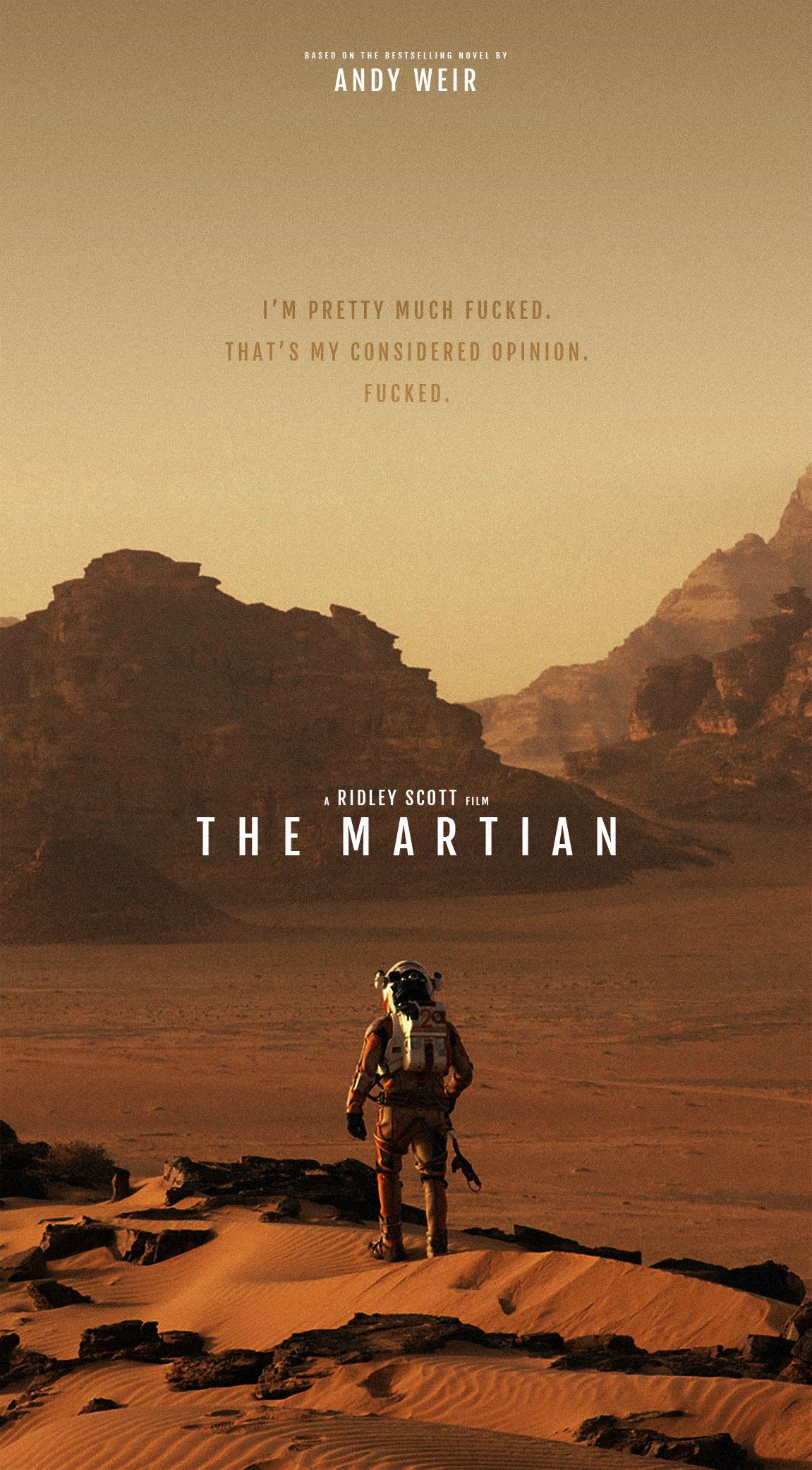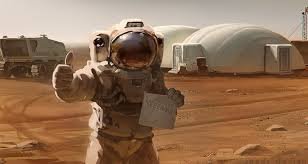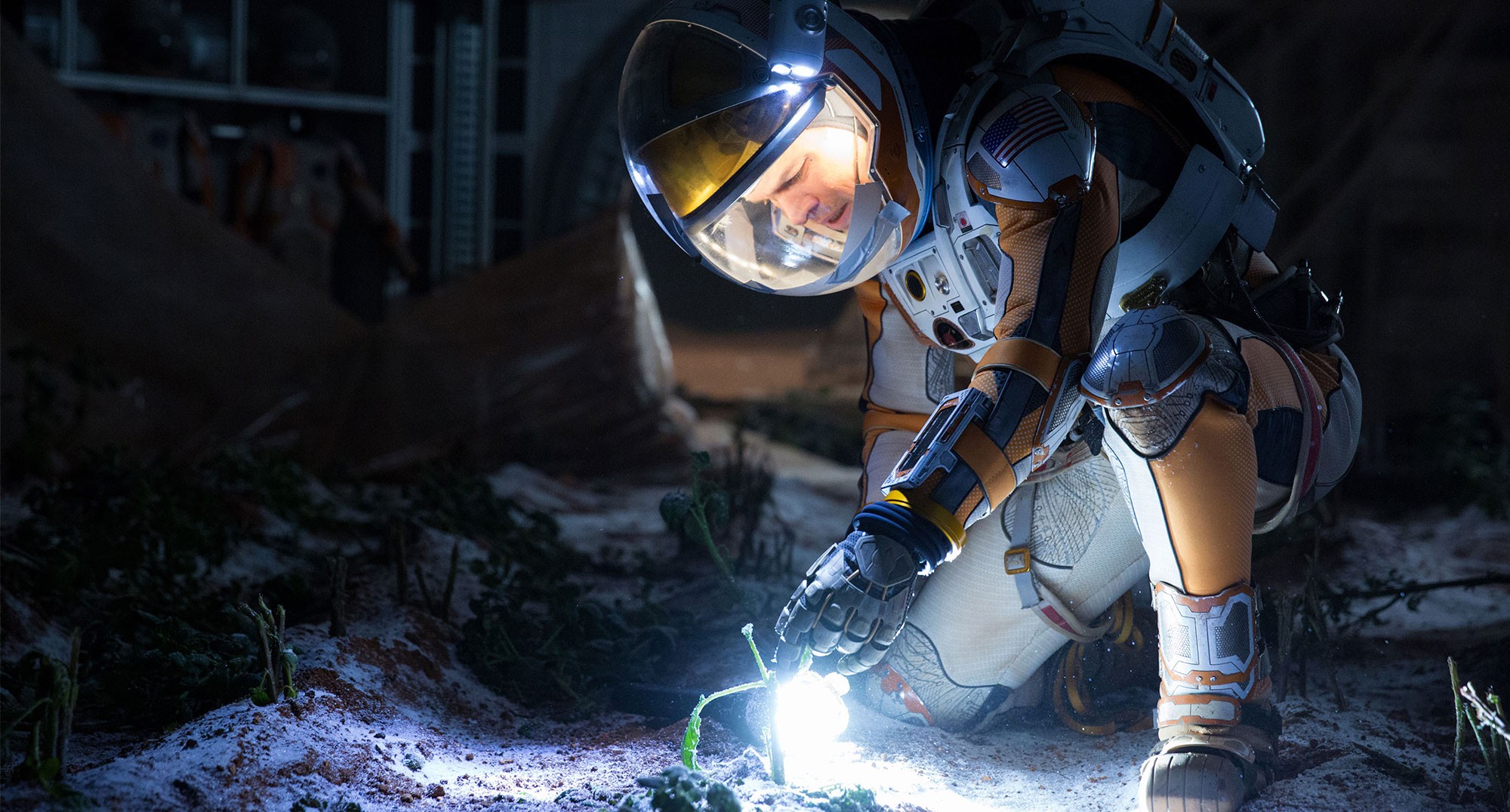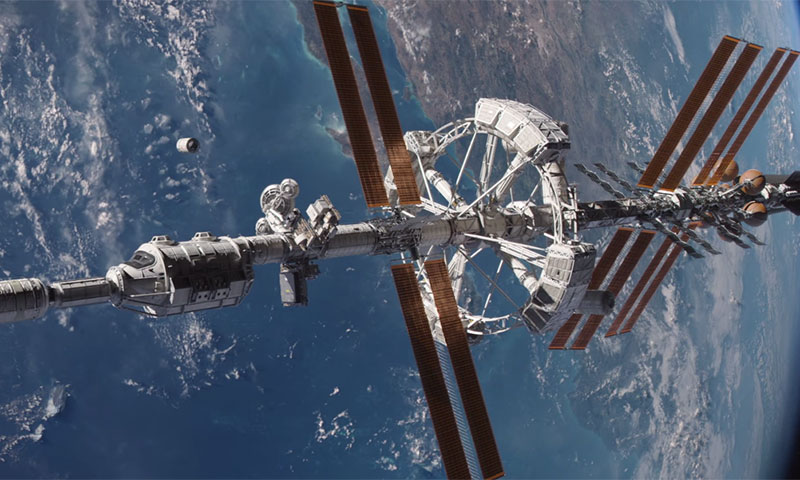USA 2015. Directed by Ridley Scott. Screenplay Drew Goddard Based on Novel Title The Martian (2011/14) Author Andy Weir Cinematography Dariusz Wolski Editor Pietro Scalia Production Design Arthur Max. Music Harry Gregson-Williams. With Matt Damon Mark Watney Jessica Chastain Melissa Lewis Kristen Wiig Annie Montrose Jeff Daniels Teddy Sanders Michael Peña Rick Martinez Sean Bean Mitch Henderson Kate Mara Beth Johanssen Sebastian Stan Chris Beck Aksel Hennie Alex Vogel Chiwetel Ejiofor Venkat Kapoor Mackenzie Davis Mindy Park Donald Glover Rich Purnell. Produced by Simon Kinberg, Ridley Scott, Michael Schaefer, Aditya Sood for Genre Films, International Traders Mid Atlantic Films, Scott Free Productions for 20th Century Fox. Running time 2.21.
Acidalia Planitia, Mars, in the near future. NASA astronaut and botanist/mechanical engineer Mark Watney is left, believed to be dead, when the Ares 3 crew are forced to evacuate the planet. A dust storm has impaled Watney with an antenna and damaged his bio-monitor computer. However, his injuries are minor, and he starts a survival program by rationing the food-supply left behind, growing potatoes with the crew’s manure in the Habitat module and making water out of the rocket fuel. After a while, NASA detects his activities, but they withhold the information from the Ares 3 crew aboard the Hermes spacecraft while deciding what to do. Watney drives one of the rovers to the nearby landing spot for the 1996 Mars expedition Pathfinder. There he recovers the lander and its communication equipment and plans for a longer drive – 3 200 kilometres – to the future Ares 4 landing spot in the Schiaparelli crater. He contacts Earth and persuades them to tell the Hermes crew about his survival. Both the NASA staff and the Ares crew are happy but also guilt-struck to hear of this. Another storm destroys the airlock to the Habitat module, and the potato plants die. Watney is again under the threat of starvation. NASA therefore decides to rush a launch of an unmanned probe with fresh supply, but the rocket explodes after a few minutes. Meanwhile, astrodynamicist Rich Purnell works out a sling-shot trajectory, whereby Hermes can go back to Mars with the help of Earth’s gravity to rescue Watney and pick up new supplies from Earth on their way. The plan succeeds with the help of a new probe from the Chinese National Space Administration. On Mars Watney travels to the Ares 4 landing site to use the already-present Mars Ascent Vehicle (MAV) for a lift-off from planet and a rendezvous with the approaching Hermes spaceship. When he finally arrives to the MAV he has to strip it of excess weight in order to get it out of Mars’ gravitational pull. Still the launch is too slow, and the MAV gets out of course. On Hermes they try to adjust to this by slowing down their craft with attitude thrusters and blowing a hole in the front airlock. Watney is rescued, and Hermes returns to Earth. Some time later Watney starts training new astronauts for life in outer space.
 Earth’s twin planet Mars has been the ambivalent place of dystopian nightmares and utopian dreams ever since H.G. Wells wrote his best-seller The War of the Worlds in 1898. In 1923 Aleksey Tolstoy’s Aelita revised Wells’ scenario by sending a Soviet expedition to the planet, instigating a revolution that turned Mars red also in spirit. A year later the novel was adapted into a prestige production by the new Bolshevik film industry. In contrast, Edgar Rice Burroughs John Carter-novels 1912–40 offered a colonialist scenario, in which an officer from the Confederate army becomes a victorious warlord and proto-fascist übermensch among savages on a new frontier.
Earth’s twin planet Mars has been the ambivalent place of dystopian nightmares and utopian dreams ever since H.G. Wells wrote his best-seller The War of the Worlds in 1898. In 1923 Aleksey Tolstoy’s Aelita revised Wells’ scenario by sending a Soviet expedition to the planet, instigating a revolution that turned Mars red also in spirit. A year later the novel was adapted into a prestige production by the new Bolshevik film industry. In contrast, Edgar Rice Burroughs John Carter-novels 1912–40 offered a colonialist scenario, in which an officer from the Confederate army becomes a victorious warlord and proto-fascist übermensch among savages on a new frontier.
When astronomers showed Mars as a desert planet where no higher life-forms was likely to be found, another narrative tradition emerged: the Robinsonade. Partly inspired by John W. Campbell’s short story “The Moon Is Hell” (1950), Robinson Crusoe on Mars (1964) updates Daniel Defoe’s story with an alien slave as the protagonist’s Man Friday. A variation of the story, mixed with John Boorman’s Hell in the Pacific (1968), was shot by Wolfgang Petersen as Enemy Mine (1985).
Mars then turned into box-office poison with string of big-budget space thrillers that wanted to profit from NASA’s plans for expeditions to the planet: Brian De Palma’s close encounters of the third kind-drama MISSION TO MARS (2000), Anthony Hoffmans sci-fi horror flick RED PLANET (2001), John Carpenter’s schlocker GHOSTS OF MARS (2001), Andrew Stanton’s epic adventure John Carter (2012) and the quickly forgotten The Last Days of Mars (2013) directed by Ruairi Robinson. But along came Andy Weir’s The Martian (2011), a self-published novel that slowly turned into a surprise best-seller. Fox purchased the film rights in 2013, and Crown re-released the novel in 2014.
While Weir’s novel is an Apollo 13 (1995) variation, in which a possible disaster and national disgrace is turned into a flag-waving triumph of American teamwork and innovation, Ridley Scott’s film adaptation goes for a Robinson Crusoe-type of narrative. Protagonist Mark Watney (Matt Damon) has to “science the shit” out of his seemingly hopeless situation, alone on a desert planet with no breathable air nor water or the possibility to grow food. Luckily he is not only a botanist and a mechanical engineer, he is also a self-reliant Western frontiersman, pirate and boy scout.
Even before he is stranded on the planet, faced with starvation and death a long way from home, we note that he is of the right (masculine) stuff in his care-free, anti-authoritarian attitude. Waking up from the dead, he soon adapts to the ethos of Henry David Thoreau’s classical novel of self-reliance and spiritual discovery in the American wilderness, Walden (1854), a book that also inspired another revisit to the frontier spirit: the novel and film WILD (2012/14). By ingenuity, the force of will and some duct/gaffa tape Watney overcomes the incredible odds stacked against him by the inhospitable wilderness.
Along the way from start to finish, the film briefly touches on other narrative formats that are only left as fragments in what ultimately became a Matt Damon one-man show. The film opens with a dark and ominous image of Mars. Its silhouette is only briefly lit; most of the planet is covered in darkness. A rumbling score and the fade-in of the film title in a thin font suggest horror. Especially so, since the director is Ridley Scott, who launched the Alien franchise in 1979 and revisited it in 2012 with Prometheus.
Then, after Mark wakes up from the catastrophic opening storm, the film switches to glaring daylight and vivid colors. This is clearly the opposite of Alien, Scott signals to us, an optimistic space adventure with no dark abysses either outside or inside of Mark Watney. Hell, he does not even go a little bonkers or watch porn or engage in any activity that deviates the slightest from his true grit character. A bit odd, really, since Tom Hank’s modern Robinson in CAST AWAY (2000) at least showed some signs of cracking up.
Later in the film, when we follow NASA’s teamwork on Earth and the Ares crew on the space ship Hermes, there is a flair of the Grand Hotel (1932) narrative. An abundance of stars pop up in small parts to add bits and pieces to the plot. Some only have one or two lines, like the actors in the subplot of the Chinese probe, but then they are only included to show that – like Independence Day (1996) – everybody is an American at heart and to widen the market for the novel and film.
At the end the film version not only adds an action-packed twist to the rescue operation, it also adds an epilogue that turns the film into recruitment propaganda for NASA. This is not unintentional as the novel’s author, Andy Weir, has been celebrated by the government agency and treated with royal tours at their facilities. NASA has also helped to market the film by publishing PROMOTION CAMPAIGNS ON THEIR WEB SITE.
 All in all, the film excels in technical achievements, but fails to engage on a human level. The Martian environment – filmed at Wadi Rum in Jordan – is convincing. So are the space crafts and the NASA facilities that were constructed at the Korda Studios in Budapest. But, as I suggested earlier, the story of Mark Watney’s ordeals on the planet is short of real human life. Psychologically, he is a cardboard character. We don’t get to know him any more than the numerous bit players who are only in the film for a fraction of the time he gets. This might be the reason for featuring some disco classics in the novel and film; to include some elements steaming with life that can get him goofing, if only for a second or two.
All in all, the film excels in technical achievements, but fails to engage on a human level. The Martian environment – filmed at Wadi Rum in Jordan – is convincing. So are the space crafts and the NASA facilities that were constructed at the Korda Studios in Budapest. But, as I suggested earlier, the story of Mark Watney’s ordeals on the planet is short of real human life. Psychologically, he is a cardboard character. We don’t get to know him any more than the numerous bit players who are only in the film for a fraction of the time he gets. This might be the reason for featuring some disco classics in the novel and film; to include some elements steaming with life that can get him goofing, if only for a second or two.
Still, The Martian is preferable to Scott’s previous film, the pompous and stilted EXODUS: GODS AND KINGS (2014). It is unusually cheerful and upbeat to be a work signed by him. Just think of all the glum and even nihilistic films he has made: besides the Alien films, titles such as Black Rain (1989), Hannibal (2001) and AMERICAN GANGSTER (2007). Here, the forbidding planet is turned into a sun-drenched place of hope and optimism. Perhaps Scott was inspired by David Lean, whose shooting of Lawrence of Arabia (1962) took place only a stone’s throw from The Martian’s locations in Jordan.
© Michael Tapper, 2015. Web exclusive: michaeltapper.se 2015-10-02.

